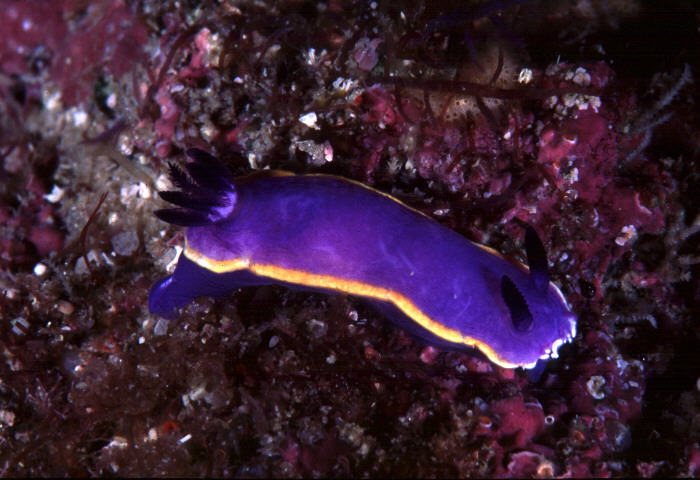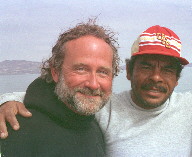 |
Mexichromis amalguae
San Benito Island
Photo courtesy of Dr. Marc Chamberlain
Mexichromis amalguae Gosliner & Bertsch, 1988
Elegant and simple in its coloration, Mexichromis amalguae is a blue to light purple blue; a median longitudinal, cream white, diffuse dorsal stripe may be present; there is a thin yellow band encircling the entire notal margin. The rhinophores and 7-9 unipinnate gills are a deep navy blue in color. It exhibits a typical small chromodorid shape, and can reach about 20 mm in total length.
This species is clearly placed in the genus Mexichromis because of the prominent vestibular gland and the acuspidate radular teeth (Rudman, 1984; Bertsch, 1977). The known radular formulae are 24 x 22.1.22 and 46 x 27.1.27.
Terry Gosliner, Dave Behrens and I had known about this species for a number of years until specimens collected in 1987 allowed us to finally name the species. Specimens have only been recorded from two nearby islands along the central portion of the Pacific coast of the Baja California peninsula--Isla Cedros and Islas San Benito.
Terry and I chose to name this species after the type locality of Isla Cedros. In describing the etymology of the species, we wrote: "When Isla Cedros was 'discovered' by the Spaniard Francisco de Ulloa in 1540, the island was inhabited by a tribe of Cochimi who called the island Amalgua, or Isle of Fogs. The European conquerors misnamed the island by misidentifying its flora, and in 1732 removed the entire native American population to the Baja California mission of San Ignacio, where their culture and population were essentially eliminated by the end of the century through the 'civilizing' effects of Europeanization and disease. We wish to honor a native culture and people by naming this new species based on the original name of the island. (The genus Mexichromis is masculine; amalguae is genitive, meaning 'of the isle of fogs,' or 'belonging to Amalgua.')" Anyone who has ever visited the island or seen it from the adjacent region of Guerrero Negro can attest to the frequent cloudy marine layer that hovers over the island.
Along the Pacific coast of the Americas (from central California, USA, to Panama) there are three other known species of Mexichromis: M. porterae (Cockerell, 1901), M. tura (Marcus & Marcus, 1967), and M. antonii (Bertsch, 1976). Mexichromis antonii (named in honor of Antonio J. Ferreira) is the type species of the genus.
Bertsch, Hans. 1977. The Chromodoridinae nudibranchs from the Pacific coast of America. Part I. Investigative methods and supraspecific taxonomy. The Veliger 20 (2): 107-118.
Gosliner, Terrence M., and Hans Bertsch. 1988. A new species of Mexichromis (Nudibranchia: Chromodorididae) from the eastern Pacific. The Veliger 31 (1/2): 127-134.
Rudman, W. B. 1984. The Chromodorididae (Opisthobranchia: Mollusca) of the Indo-West Pacific: a review of the genera. Zool. Jour. Linn. Soc. 81: 115-273.
Text courtesy of Dr. Hans Bertsch.

Assoc. Prof. |
